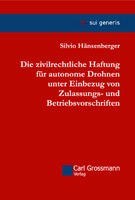Die zivilrechtliche Haftung für autonome Drohnen unter Einbezug von Zulassungs- und Betriebsvorschriften
| dc.contributor.author | Hänsenberger, Silvio | |
| dc.date.accessioned | 2019-03-08 16:07:08 | |
| dc.date.accessioned | 2020-04-01T10:49:42Z | |
| dc.date.available | 2020-04-01T10:49:42Z | |
| dc.date.issued | 2018 | |
| dc.identifier | 1004293 | |
| dc.identifier | OCN: 1100525218 | en_US |
| dc.identifier.uri | http://library.oapen.org/handle/20.500.12657/25796 | |
| dc.description.abstract | The characteristics and abilities of autonomous drones pose major challenges for liability law. Nowadays only personal injury and damage to property on the ground are covered by strict liability (Art. 64 para. 1 Swiss Aviation Act). Injured parties are in danger of being left without legal protection in the event of mid-air collisions, as claims for damages cannot be asserted on the basis of erroneous decisions by an algorithm, either through liability for wilful or negligent wrongdoing (Art. 41 para. 1 Swiss Code of Obligations) or product liability. The same applies to purely pecuniary loss. The question of liability for wilful or negligent wrongdoing arises only if duties of care were violated when using autonomous drones. Such duties of care may ensue from permit and operating regulations. Currently autonomous flights without the possibility of direct control and beyond a pilot’s field of vision are allowed only with special permits. As international efforts show, such barriers will come down in future. Appropriate licensing and operating regulations as described in this dissertation will therefore be required. At the same time it will be necessary to extend strict liability under aviation law for unmanned aircraft that are not steered by a pilot to damage in the event of mid-air collisions and to purely pecuniary damage. The specific legal formulations and their legislative implementation are proposed and discussed here for this purpose. | |
| dc.language | German | |
| dc.relation.ispartofseries | sui generis | |
| dc.subject.classification | thema EDItEUR::L Law | en_US |
| dc.subject.classification | thema EDItEUR::L Law::LA Jurisprudence and general issues | en_US |
| dc.subject.classification | thema EDItEUR::L Law::LN Laws of specific jurisdictions and specific areas of law::LNC Company, commercial and competition law: general::LNCB Commercial law::LNCB6 Aviation law | en_US |
| dc.subject.classification | thema EDItEUR::T Technology, Engineering, Agriculture, Industrial processes::TJ Electronics and communications engineering::TJF Electronics engineering::TJFM Automatic control engineering::TJFM1 Robotics | en_US |
| dc.subject.other | Law | |
| dc.subject.other | Public Liability Law | |
| dc.subject.other | Aviation Law | |
| dc.subject.other | Robots Law | |
| dc.subject.other | Robotics | |
| dc.subject.other | Autonomous Systems | |
| dc.subject.other | Drones | |
| dc.subject.other | unmanned aerial vehicle | |
| dc.subject.other | Recht | |
| dc.subject.other | Haftpflichtrecht | |
| dc.subject.other | Luftrecht | |
| dc.subject.other | Roboterrecht | |
| dc.subject.other | Robotik | |
| dc.subject.other | autonome Systeme | |
| dc.subject.other | Drohnen | |
| dc.title | Die zivilrechtliche Haftung für autonome Drohnen unter Einbezug von Zulassungs- und Betriebsvorschriften | |
| dc.type | book | |
| oapen.abstract.otherlanguage | Die Eigenschaften und Fähigkeiten autonomer Drohnen stellen das Haftpflichtrecht vor grosse Herausforderungen. Heute sind nur Personen- und Sachschäden auf der Erde durch eine Gefährdungshaftung (Art. 64 Abs. 1 LFG) gedeckt. Bei Luftkollisionen drohen Geschädigte ohne Rechtsschutz zu bleiben, da Schadenersatzansprüche aufgrund von Fehlentscheidungen eines Algorithmus weder mittels Verschuldenshaftung (Art. 41 Abs. 1 OR) noch mit der Haftung für Produkte durchsetzbar sind. Dasselbe gilt bei reinen Vermögensschäden. Einzig falls beim Einsatz autonomer Drohnen Sorgfaltspflichten verletzt wurden, kommt eine Haftung aus Verschulden infrage. Solche Sorgfaltspflichten können sich aus Zulassungs- und Betriebsvorschriften ergeben. Heute sind autonome Flüge ohne direkte Kontrollmöglichkeit und ausserhalb des Sichtbereichs eines Piloten nur mit Ausnahmebewilligungen erlaubt. Künftig werden solche Schranken wegfallen, wie internationale Bestrebungen zeigen. Dafür sind sachgerechte Zulassungs- und Betriebsvorschriften notwendig, die in dieser Dissertation beschrieben werden. Gleichzeitig bedarf es einer Ausdehnung der luftrechtlichen Gefährdungshaftung für unbemannte Luftfahrzeuge, die nicht durch einen Piloten gesteuert werden, auf Schäden bei Luftkollisionen und auf reine Vermögensschäden. Zu diesem Zweck werden vorliegend konkrete Gesetzesformulierungen vorgeschlagen und deren gesetzgeberische Umsetzung erörtert. | |
| oapen.identifier.doi | 10.24921/2018.94115928 | |
| oapen.relation.isPublishedBy | 17bcfe22-3dfb-4fa9-baa3-ad2dce71b76c | |
| oapen.relation.isFundedBy | 07f61e34-5b96-49f0-9860-c87dd8228f26 | |
| oapen.relation.isbn | 9783941159273 | |
| oapen.collection | Swiss National Science Foundation (SNF) | |
| oapen.series.number | 3 | |
| oapen.pages | 304 | |
| oapen.place.publication | Berlin; Bern | |
| oapen.grant.number | 10BP12_183570 | |
| oapen.grant.program | Open Access Books | |
| oapen.grant.project | Die zivilrechtliche Haftung für autonome Drohnen unter Einbezug von Zulassungs- und Betriebsvorschriften | |
| oapen.identifier.ocn | 1100525218 |

